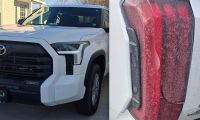This past weekend has been somewhat normal and weird, with progress reported in the thousands of chipless trucks parked at airports and former sports stadiums around the country and with some back-to-the-past action in Wyoming.
Putting Things Into Perspective
To put things in perspective, during the deepest days of the pandemic, multiple problems beset the auto industry. Not only were people staying away from dealerships, but they were also refraining from buying new vehicles at those same dealerships.
At that time – at the end of 2019 and into 2020 – people didn’t know what COVID really was. While there were certain indications of the damage, it could do as the illness soared and statistics kept on being surpassed in the numbers in hospitals and intensive care units, people stayed sheltered in their homes.
Like the rest of us, dealers, who do want to sell cars most of the time, were pulling back, and while they welcomed customers, they weren’t going to the ends of the earth to round them up either. Okay, that might be a bit of hyperbole, it does pretty much cover the situation three years ago. Indeed, the auto industry shut down many assembly lines to keep its workers safe.
Things Begin To Loosen Up; Lines Reopen
In late 2021, the industry began to loosen up and reopen assembly lines as demand started returning. We were entering the second year of the pandemic, and folks were getting optimistic that things would get better. As the lines loosened, though, the auto industry started noticing that things had changed for the industry. As Ford reopened its lines, it noticed that some of the parts and supplies that it depended on for its just-in-time building process (the auto industry kept a very low level of parts inventory, preferring to let suppliers deliver right to loading docks at the factory – while a simplistic explanation it does cover things).
Where it expected its semiconductor suppliers to deliver the chips it needed for its F-150s and other vehicles, there was a big empty. The reason given was supply chain problems. What they didn’t mention was those supply chain problems were caused by their semiconductor suppliers changing their fab lines from the semiconductors the automaker needed by the board-full to other industries where the profit margin was fatter. It precipitated a problem that continued from late 2021 through most of 2022 to now.
This caused a major problem for Ford – and others – in that the auto industry, which had now reawakened from its pandemic slumber, needed chips right away. The problem was that the semiconductor plants elsewhere were not answering the needs of the auto industry, but the carmakers had to produce their trucks and SUVs to keep their lines humming.
The industry came up with a solution that could have been more innovative but, at the same time, interesting. To keep its lines up and running, Ford and others built the vehicles that were scheduled to be churned out of various truck assembly plants. The trucks looked like they were ready to roll off the lines and into dealer lots. But they weren’t because the carmaker partially finished them. Ford held its diminishing supplies of semiconductors for its newest models to get them out to dealerships. Thousands of trucks that looked perfectly fine on the outside were left essentially chipless, while others that were completed were sent to dealers. However, they may have been short a chip or two and ultimately committed to making sure customers had vehicles that worked correctly.
Thousands Were In Storage Waiting
That still left thousands of other F-150s and other vehicles that needed to be completed when the chips caught in the supply chain problem were available again. So, what did Ford do? It rented space at unused airports and unused sports stadiums and proceeded to stack its vehicles up there as it waited for the chips to become available. Thousands of vehicles were placed in this storage limbo, neither fit for sale nor fit for much else except waiting.
It has taken until very recently – the last month or two – for the badly needed semiconductors to appear at the loading bay doors so that they can be installed in the vehicles that needed them so badly.
According to a major survey article this week, vehicles that have been waiting in storage – some for almost two years – are finally getting their “brains.” MSN News reported over the last weekend that the chips have finally become available for the many vehicles waiting to be installed. And, while it has taken some time to be accomplished, the vehicles in storage may soon be heading into the field for sale to customers.
Ford Motor Photo
Marc Stern has been an automotive writer since 1971 when an otherwise normal news editor said, "You're our new car editor," and dumped about 27 pounds of auto stuff on my desk. I was in heaven as I have been a gearhead from my early days. As a teen, I spent the usual number of misspent hours hanging out at gas stations (a big thing in my youth) and working on cars. From there on, it was a straight line to my first column for the paper, "You Auto Know," an enterprise I handled faithfully for 32 years. Not many people know that I also handled computer documentation for a good part of my earnings while writing YAN. My best writing, though, was always in cars. My work has appeared in Popular Mechanics, Mechanix Illustrated, AutoWeek, SuperStock, Trailer Life, Old Cars Weekly, Special Interest Autos, etc. You can follow me on: Twitter or Facebook.











